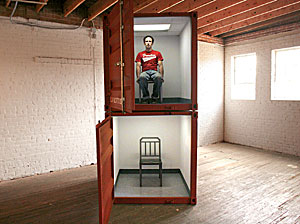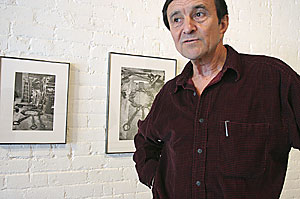 |
|
CASSIE TOMLIN/Arizona Daily Wildcat
|
"State Furniture" - Dave Lewis sits in his latest sculpture on exhibit at the Museum of Contemporary Art. "State Furniture," a collection of Lewis' work, will be at Moca until May 15.
|
|
|
By Lauren Hillery
Arizona Daily Wildcat
Thursday, March 24, 2005
Print this
Photography may be the most accurate visual representation of reality, while sculpture can offer the most abstract and symbolic representation of reality. But the Museum of Contemporary Art's new exhibit uniquely combines the two with the exhibits "Dave Lewis: State Furniture" and "Dan Budnik: David Smith at Work."
As a part of their Origins series that examines the roots of post-modern art, this exhibition presents Budnik's poignantly real photography of the great 20th century sculptor David Smith as a compliment to Lewis' socially critical sculpture exhibit that examines power.
"This exhibit represents the relationship between photography capturing sculpture and sculpture," said Anne-Marie Russell "State Furniture" curator.
Budnik's photography, although more than 40 years old, offers a rare and honest look at the meticulous work process of Smith.
"He was probably the artist I photographed the best. There was something about his work ethic. In terms of people I've witnessed in the act, he was the most compelling. I am indebted to the experience I had working with him," Budnik said. "The day I stepped into his studio I knew I had to capture what he was doing. It was the highlight of my life."
Smith utilized a time card for himself and his only assistant and even his breaks were focused, usually with no conversation, Budnik said.
Budnik's photographs come from the time he spent at Smith's home and studio after he finally accepted Smith's 10-year-long invitation to photograph him at work.
 |
|
CASSIE TOMLIN/Arizona Daily Wildcat
|
"David Smith at Work" - Dan Budnik stands with photographs he took of sculptor David Smith in 1962. Budnik and the Museum of Contemporary Art curator will hold a "walk and talk" of the exhibition "David Smith at Work" at MOCA tomorrow at 6 p.m.
|
|
|
Even though Smith inspired Budnik, it was a struggle to convince anyone to take an interest and publish his photos. Budnik had been previously rejected by Life magazine, but he finally forcefully convinced them to look at his work.
"I said, 'I'm asking you to look at the photos, that's your job right?'" Budnik said.
Twenty minutes later, after tracking down the managing editor on the street, the photo spread was guaranteed to be in the next issue. Budnik's exposure of Smith cemented Smith's talent and became a source of public awareness.
Smith's sphere of influence expanded rapidly and pioneered the genre. For example, Lewis, a UA alumnus, is just one of the many Smith influenced.
"My debt to Smith is twofold. The opportunity to work with the materials I'm choosing is a debt. I wouldn't have had the personal strength to invent a medium," Lewis said.
Lewis's exhibit attempts to pin down the idea of power: where it comes from, why certain people have it and certain people don't and why it's so forceful, Lewis said. But he emphasizes that his work is not meant to be an attack.
"There's this force that I'm really trying to figure out - what it is and how it works. It doesn't work with physics or like anything we're told in our civics class. Power demonstrates what a single person can do," Lewis said.
Lewis' installment includes a variety of pieces ranging from a set of 16 handcuffs in a display case to a hand-knitted ski mask to the gallows.
For Lewis, inspiration was not the correct word to describe the origin of his ideas, due to the dark and almost brutal nature of his pieces.
"I don't really know if inspiration is it. I have some other sensation. Inspiration sounds so positive and happy. Some of the things I worry about making in the gallery are lethal. It doesn't cater to inspiration," Lewis said. "I feel around in the dark to see what's there."
"State Furniture" offered Lewis a chance to do things much differently than he had done before. One set of pieces in the exhibit is a collection of eight lecterns created in a very similar, stark and mechanical way. Prior to their installment in the exhibit, Lewis set them on various street corners throughout the city for six weeks.
"I never made public art without a permit before. I wanted the public to interact with them without an artsy context," Lewis said.
The pieces now stand in the exhibit basically untouched from their state on the street, including the dust, graffiti and posters that were left on them.
"Each piece is marked by its location. Bird crap and all the dust is exactly how it was when I took it from the street," Lewis said.
Another installment that deviates from Lewis' usual style is the collection of security camera photographs. Lewis took a photograph of every security camera within a one-mile radius of his studio. For Lewis there is a connection between security cameras and the power of the state.
"There's something about being watched that speaks to state power. Looking, watching, omniscience is one aspect of power," Lewis said. "It's hard to put your finger on the center of power."
Lewis' exhibit also includes a large-scale version of the schematic that he used to outline this vision. The schematic looks like a traditional pie graph but explains the relation between each sculpture and the specific form of power it represents.
James Swensen, curator for Budnik's exhibit, will speak about the exhibit today. On April 7, Lewis will speak on his own work and Nancy Bentley, Lewis exhibit curator and Russell will speak on "State Furniture." Also, the Museum of Contemporary Art, the affiliate group, will host "Conversations with Joan Juliet Black," which will be live interviews both Budnik and Lewis. A published interview of Black and Lewis is part of an 88-page catalogue, which can be purchased for $20 at the museum.
The exhibits run through May 15. Museum of Contemporary Art, 19 E. Toole Ave., is open Tuesday through Sunday from noon to 5 p.m. All public events are free to members and $5 for non-members. For any questions call 624-5019.
